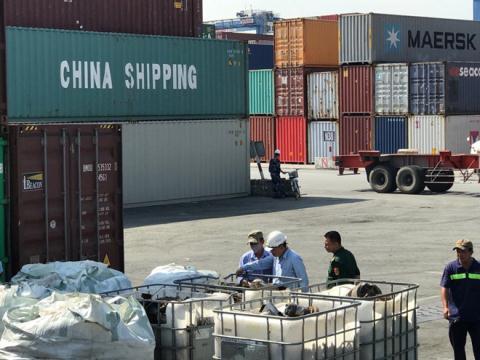A report of the General Department of Customs (GDC) showed that by mid May, Vietnam had imported $4.36 billion worth of machines and equipment from China. This was the second biggest import item, after computers and electronics.

As such, the volume of machines and equipment imported from China in the first months of the year increased by 29 percent compared with the same period last year, with an increase of 34 percent in April alone.
The imports from China accounted for 37.6 percent of total imports of products. The second biggest supplier of products was South Korea ($2.1 billion, up by 12.18 percent), and the third was Japan with $1.5 billion.
|
The imports from China accounted for 37.6 percent of total imports of products. The second biggest supplier of products was South Korea ($2.1 billion, up by 12.18 percent), and the third was Japan with $1.5 billion. |
Analysts say China is racing with the US and Europe in developing 4.0 industries, resulting in the elimination of a high volume of outdated machines and equipment believed to be exported to developing countries, including Vietnam.
Nguyen Tri Hieu, a respected economist, has warned that Vietnam may become a technology dumping ground for China which is trying to liquidate outdated technologies.
“The further China advances in technology development, the further it leaves Vietnam behind. What I'm worried about is that China seems to be trying to export outdated technology to neighboring countries, including Vietnam,” Hieu said.
Chinese investment in Vietnam reached $2 billion in the first five months of the year, making China the top foreign investor in Vietnam.
Le Cao Doan from the Vietnam Economics Institute expressed concern about the dark side of Chinese investment, saying Chinese capital does not bring new production methods.
The latest annual report on Vietnam’s economic performance released by VEPR on May 29 also mentioned the risk of increasing the trade deficit with China.
There are two reasons behind the increased trade gap, according to economist Pham The Anh, including increased Chinese FDI which brings more equipment to Vietnam, and the depreciation of the yuan.
VEPR’s director Nguyen Duc Thanh, noting that Vietnam’s economy grew more slowly in the first months of 2019 in comparison with the same period last year, projected two economic growth scenarios.
First, a GDP growth rate of 6.56 percent, about the level targeted by the National Assembly. This could happen in the context of the world’s unfavorable conditions because of tensions from the US-China trade war. With the second scenario, the GDP growth rate would be 6.81 percent.
Hoang Vu

Trade war likely to dampen VN markets this week
Rising fears about the US-China trade war are forecast to continue to drag down market sentiment and dampen investor confidence.

The trade war rages on
The Sino-American trade war is escalating in unpredictable ways. Contrary to some analyses, its impacts on Vietnam are arguably beneficial. A vulnerable economy such as Vietnam’s is unlikely to benefit from this global war.
 The US-China trade war and Chinese yuan devaluation have increased the risk of a widening trade gap, with more imports from China flowing to Vietnam.
The US-China trade war and Chinese yuan devaluation have increased the risk of a widening trade gap, with more imports from China flowing to Vietnam.